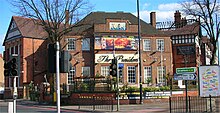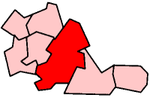Sparkhill
This article includes a list of general references, but it lacks sufficient corresponding inline citations. (June 2020) |


Sparkhill is an inner-city area of Birmingham, England, situated between Springfield, Hall Green and Sparkbrook.
History
The Sparke family
In the
The Cherry Arbour
As a result of the Industrial Revolution which was causing Birmingham to expand, development of the area began. In the 1850s, a small area of land was bought by a building society and sold to separate developers who built houses for the working class. People who owned a property were entitled to vote and a campaigner for the working class vote was Joseph Sturge, a Birmingham manufacturer. As a result of his campaigning, a newly created street in the area was named after him. The architecture of the houses was varied due to the different developers. A centre began to develop for the area with its own pub, The Cherry Arbour.
In the late 1860s, developments appeared all over Sparkhill with the creation of long, straight streets forming a uniform pattern. The new houses were terraced with their own back garden, coal shed and lavatory. For the wealthy middle class, larger houses were built in a plot bounded by Stoney Lane, Alfred Road and Durham Road.
Annexation by Birmingham


Sparkhill was removed from
World War II
As a result of the nearby BSA factory being targeted, the area suffered from bombing in World War II, resulting in the loss of some houses, and their 1940s replacement (e.g. the houses at 180–190 Osborne Road). A memorial to those from the BSA works who died during the Second World War can be found in St John's Church.
Public houses
Another old landmark in Sparkhill is the Mermaid Inn, which has been the site of a pub since the 17th century. The building was converted into a

Other pubs, the Bear and
Immigration
In the 20th century, the area became heavily influenced by migrants who settled in the area.[
Notable residents of Sparkhill
- Bev Bevan, drummer with the Move and the Electric Light Orchestra
- Charlie Timmins, Coventry City captain
- Gil Merrick, Birmingham City goalkeeper
- John Bentley, actor born in Sparkhill (1916)
- Kevin McDonald, archbishop
- Lock Up, band
- Guantanamo Baydetainee
- Paul Bliss, keyboard player with the Moody Blues, the Hollies and the Bliss Band
- Moeen Munir Ali, England international cricketer
- Robert Melville, art critic
- Sid Field, comedian
- Roland Gift, actor and lead singer of Fine Young Cannibals
- Simon Inglis, architectural historian, writer and broadcaster
- Mona Washbourne, actress
In popular culture
The BBC sitcom
References
- ^ "Sparkbrook: History". 5 August 2010.
- ^ "Sparkhill".
- Brum and Brummies: Vol 2, Chapter 3: The Old End – The Hills are Alive: Sparkhill, ISBN 1-85858-202-4)
- Public Sculpture of Birmingham including Sutton Coldfield, George T. Noszlopy, edited Jeremy Beach, 1998, ISBN 0-85323-692-5
External links
- BBC – Life in Sparkhill feature (with photos)
- 1890 Ordnance Survey map of Sparkhill (in top left corner)

